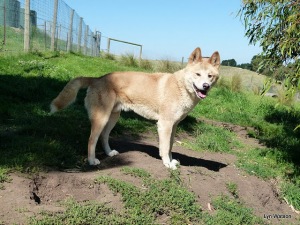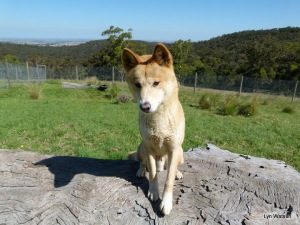The name tags kept disappearing, and the staff at Melbourne’s Dingo Discovery and Research Centre was mystified. After romping around the grounds of the dingo sanctuary, Sterling, an 18 month old sub adult male, and his two canine companions spent time in an indoor enclosure that had a name tag posted on the outside of the steel mesh wall. The tag was positioned 1.7 meters above the ground, well out of dingo-reach. Still, it kept vanishing.
As reported in a paper published online last week in Behavioural Processes,1 the caretakers decided that it was time solve the mystery. First, they hung a small plastic envelope filled with food near the name tag and watched to see what the dingoes would do. The dingoes were having none of that, however – as long as observers were around, the dingoes studiously ignored both the name tag and the envelope of food. Since the direct approach clearly wouldn’t work, the staff resorted to sneakiness, rigging up a video camera and then leaving the dingoes to their own devices.
Success! When the staff returned to the enclosure, they found that the food was gone and, more importantly, that the videotape reflected perhaps the first documented instance of tool use by a member of the Canid family. As described in the Behavioural Processes paper:

Big deal, Lassie; when Timmy fell down *my* well, I hoisted him out using a system of pulleys. (Sterling at Dingo Discovery and Research Centre, photo by Dingo Lyn)
[A]fter several unsuccessful attempts at jumping for the envelope, Sterling “solved” the task by first moving and then jumping up onto a trestle table (1.2 m × 0.6 m × 0.73 m) which allowed him to gain the additional height necessary to reach the food item. To move the table, Sterling clamped his mouth onto the strut between the legs of the table. He then walked backwards, dragging the table approximately 2 m, until it appeared that either his back leg or tail touched the enclosure mesh. He then jumped onto the table, but as he was still at least a body-length away from the envelope, he had to span the gap between the table and the enclosure mesh by propping his front paws onto the mesh gradually moving them towards the envelope. At full stretch, he reached the envelope on his second attempt.
While this account of Sterling’s actions may sound impressive, it’s even more striking when seen on video:
…
Bradley Smith of the University of South Australia and his colleagues noted in their paper that Sterling’s behavior appeared to be spontaneous – he had never been trained or encouraged to position the table in order to reach food (or name tags) – but they cautioned that they had to rely on information provided by the sanctuary’s staff regarding Sterling’s (lack of) relevant training in the past.

No problem, just bring me a socket wrench, a crow bar and three sticks of gum... (Sterling at Dingo Discovery and Research Centre, photo by Dingo Lyn)
Sterling, for his part, was no one-hit wonder. According to sanctuary staff, from an early age Sterling was adept at manipulating his environment to serve his purposes. For example, during one breeding season he used his front paws to roll a barrel to a wall, jumped up on the barrel, scrambled over the wall, and approached a female dingo in another area of the sanctuary. Also, the staff and research team later videotaped separate occasions in which Sterling used his mouth to drag a plastic dog kennel to differing locations around his enclosure, allowing him to stand on the kennel and peer over walls into neighboring dingo enclosures.
Thus, while the researchers couldn’t exclude the possibility that Sterling’s problem-solving abilities were the result of observational learning or that they had somehow been reinforced when he was younger, they rightly recognized that he appeared to be engaging in “high order behaviour” in using tools within his environment to solve complex problems. (Indeed, on the face of it, Sterling’s problem-solving is quite very reminiscent of Kandula the elephant’s insightful use of a box within his yard to solve an out-of-reach food challenge.)
So, now that you know what canines are capable of, please feel free to ask your dog Barkley when he’s going to get around to assembling that futon you bought at Ikea. No more excuses.
_____
![]() 1Smith, B., Appleby, R., & Litchfield, C. (2011). Spontaneous tool-use: An observation of a dingo (Canis dingo) using a table to access an out-of-reach food reward Behavioural Processes DOI: 10.1016/j.beproc.2011.11.004.
1Smith, B., Appleby, R., & Litchfield, C. (2011). Spontaneous tool-use: An observation of a dingo (Canis dingo) using a table to access an out-of-reach food reward Behavioural Processes DOI: 10.1016/j.beproc.2011.11.004.
2As we’ve noted in previous posts (see, for example, the post on the poison rat and the tuskfish tool post), scientific authorities have defined the concept of “tool use” in various ways. In the Beck and Shumaker treatise discussed in the poison rat post, the authors describe a couple of anecdotal instances that may qualify as canid tool use under their broad definition, including an account of a wolf mother who used meat as a “baiting” and “enticing” tool to distract her young pup. Fox, M. (1971). Possible Examples of High-Order Behavior in Wolves Journal of Mammalogy, 52 (3) DOI: 10.2307/1378613.
